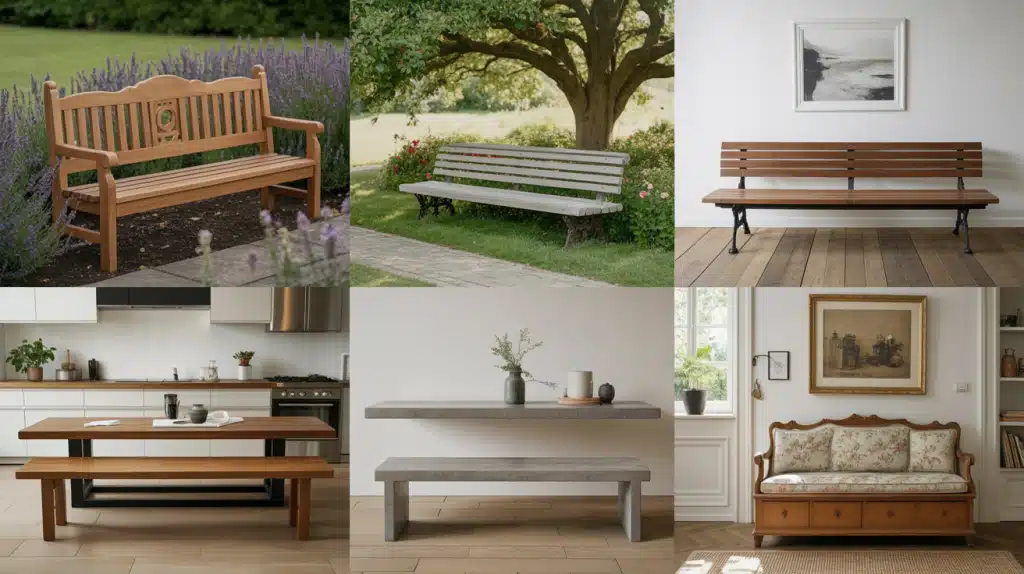When selecting the ideal bench for your space, one of the most important aspects to consider is its height.
When furnishing a home, office, or garden, selecting the correct bench height has a significant impact on comfort, posture, and visual harmony. A bench that’s too tall or too short may cause discomfort and disrupt the balance of the space.
This guide explains why bench height is so essential, offers practical tips for selecting the right dimensions for various environments, and highlights key design factors to consider.
Let’s see how to choose the right bench height for your needs.
Why Bench Height Matters?
The height of a bench plays a crucial role in ensuring comfort, usability, and overall well-being.
If you’re using a bench for dining, relaxation, or as a decorative piece, choosing the right height can significantly impact your posture and comfort level.
Understanding the importance of bench height helps you make a well-informed decision for both style and functionality.
Standard Bench Heights by Type
Every bench style has its ideal height, based on how and where it’s used. Here’s a quick guide:
| Bench Type | Typical Height Range | Why This Works |
|---|---|---|
| Garden Benches | 17–19 inches | Relaxed, easy seating for outdoor spaces. |
| Park Benches | 17–19 inches | Comfortably suits most users in public spots. |
| Dining Benches | 18–20 inches | Matches dining table height (28–30 inches) for comfortable eating. |
| Storage Benches | 18–20 inches | Balances seat comfort with extra storage underneath. |
| Entryway Benches | 18–20 inches | Perfect for putting on or removing shoes easily. |
| Backless Benches | 17–19 inches | Flexible, simple seating that fits various rooms. |
Most benches fall between 17 and 20 inches high, based on ergonomic research that accommodates a wide range of body types.
How to Measure for the Perfect Bench Height
Measuring properly ensures your bench feels just right. Here’s how:
Decide the purpose: Dining, outdoor lounging, or entryway convenience?
Check for matching furniture: Ensure the table height matches for dining benches. The standard gap between the seat and the table bottom should be about 12 inches.
Measure your leg comfort: Sit in a chair you like, and measure from the floor to where your thighs meet the seat. That’s your ideal height.
Test with cushions: If using cushions, factor in their thickness; they’ll raise the seat by 1–2 inches.
Use a tape measure: Mark the height on a wall or piece of furniture to visualize how it fits in the room.
How Improper Height Can Lead to Poor Posture
An incorrectly sized bench can create several discomforts and health issues. Here’s how:
- Too low: If the bench is too low, getting up becomes challenging, placing extra strain on your legs and back. Sitting for long periods can also feel cramped and uncomfortable.
- Too high: A bench that’s too high forces your knees above your hips, promoting poor posture and a slouched position, which can lead to back pain and discomfort.
- Long-term Effects: Over time, improper bench height can contribute to muscle fatigue, joint discomfort, and poor posture, affecting overall Well-being.
Types of Benches and Their Purpose
Benches come in a variety of styles, each designed for a specific purpose and setting. The height of a bench can vary depending on its intended use, comfort needs, and aesthetic preferences.
Here’s an overview of some common types of benches and how their design influences their height:
1. Garden Benches
- Purpose: Typically used in Outdoor settings like gardens, parks, or patios.
- Height Impact: Garden benches are generally designed for comfort and relaxation. Their height usually ranges from 17 to 19 inches, allowing for easy seating and standing, making them comfortable for prolonged outdoor use.
2. Park Benches
- Purpose: Found in public spaces like parks, waiting areas, or along walking trails.
- Height Impact: Similar to garden benches, but often designed for durability. Heights typically fall within the 17–19 inch range, ensuring they’re comfortable for a wide range of users.
3. Dining Benches
- Purpose: Often placed around dining tables in homes or restaurants for additional seating.
- Height Impact: Dining benches are typically taller than garden benches, around 18–20 inches, to align with the standard height of dining tables (28–30 Inches). This ensures comfortable seating during meals.
4. Storage Benches
- Purpose: Used for both seating and storage, often found in entryways or bedrooms.
- Height Impact: These benches are designed to be versatile. The height can range from 18 to 20 inches to match standard seating heights while also offering convenient storage space beneath.
5. Entryway Benches
- Purpose: Placed near doors for quick seating, often with hooks or shoe racks.
- Height Impact: These benches are usually in the same height range as dining benches (around 18 Inches) to accommodate shoes and ease of use when putting on or taking off outerwear.
6. Backless Benches
- Purpose: It can be used in both indoor and outdoor settings, often as additional seating along walls or at the foot of A bed.
- Height Impact: These benches are typically the same height as dining or entryway benches, at about 17–19 inches, but they may vary slightly depending on design preferences.
Industry Standards and Why They’re Ideal
Standard measurements for bench heights are not arbitrary; they’re based on ergonomic principles and decades of design research aimed at providing comfort and practicality.
Industry standards typically fall within the 17–20 inch range for most types of benches. These measurements are designed to accommodate a wide range of body types and ensure that users can sit down and stand up easily, without strain.
- Comfort: The ideal height allows for a natural, relaxed posture when sitting.
- Usability: Standard heights ensure benches are accessible and functional in various spaces.
- Versatility: These height ranges are flexible enough to be used in A variety of environments, from public parks to cozy living rooms.
Design Factors that Affect Bench Height
When choosing the right bench, several design factors come into play that can influence its height, ensuring comfort, functionality, and aesthetic appeal.
- User comfort and posture: The bench’s height should be chosen to suit the average user’s comfort. If it is too high or too low, It Can lead to discomfort, particularly in the knees and back.
- Bench function: The primary use of the bench (e.g., seating, storage, or decoration) plays a significant role in determining the height. A storage bench may be slightly taller to accommodate space underneath, while a seating bench should prioritize comfort.
- Aesthetic preferences: The design and style of the bench will influence its ideal height. For example, a modern minimalist bench may have a slightly lower profile, while a more traditional or ornamental bench could have a taller design.
- Space and room dimensions: The bench height should complement the size of the room or space where it will be placed. A taller bench might look out of place in a small or narrow room, while a lower bench might seem lost in a spacious environment.
- Outdoor vs. indoor use: The location of the bench can influence the height. Outdoor benches may have slightly different height requirements for durability and comfort.
To sum up
Choosing the correct bench height is more than a design detail; it’s a crucial factor in creating a comfortable and functional space.
From dining rooms to outdoor patios, the right measurements can enhance posture, improve usability, and ensure a cohesive look.
If you’re planning to update your space, start by measuring carefully and comparing standard heights for your specific setting. Don’t leave comfort to chance; make bench height a priority in your design decisions.
Ready to upgrade your seating experience? Select the right bench height to change your space with confidence.
Frequently Asked Questions (FAQs)
How Tall Should a Bench Be for a Dining Table?
Generally, 18–20 inches high to pair comfortably with a 28–30 inch dining table.
Can I Adjust the Bench Height if Needed?
Yes! Use thicker seat cushions or risers for extra height. For lowering, choose thinner pads or custom-cut legs.
What’s the Standard Bench Height for Entryways?
Around 18 inches is ideal for slipping shoes on and off without bending awkwardly.


